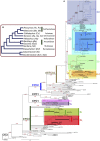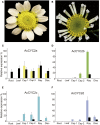Evolution and Expression Patterns of CYC/TB1 Genes in Anacyclus: Phylogenetic Insights for Floral Symmetry Genes in Asteraceae
- PMID: 28487706
- PMCID: PMC5403951
- DOI: 10.3389/fpls.2017.00589
Evolution and Expression Patterns of CYC/TB1 Genes in Anacyclus: Phylogenetic Insights for Floral Symmetry Genes in Asteraceae
Abstract
Homologs of the CYC/TB1 gene family have been independently recruited many times across the eudicots to control aspects of floral symmetry The family Asteraceae exhibits the largest known diversification in this gene paralog family accompanied by a parallel morphological floral richness in its specialized head-like inflorescence. In Asteraceae, whether or not CYC/TB1 gene floral symmetry function is preserved along organismic and gene lineages is unknown. In this study, we used phylogenetic, structural and expression analyses focused on the highly derived genus Anacyclus (tribe Anthemidae) to address this question. Phylogenetic reconstruction recovered eight main gene lineages present in Asteraceae: two from CYC1, four from CYC2 and two from CYC3-like genes. The species phylogeny was recovered in most of the gene lineages, allowing the delimitation of orthologous sets of CYC/TB1 genes in Asteraceae. Quantitative real-time PCR analysis indicated that in Anacyclus three of the four isolated CYC2 genes are more highly expressed in ray flowers. The expression of the four AcCYC2 genes overlaps in several organs including the ligule of ray flowers, as well as in anthers and ovules throughout development.
Keywords: Anacyclus; Asteraceae; CYC/TB1; CYC2 diversification; CYCLOIDEA; floral symmetry.
Figures



References
-
- Barker M. S., Kane N. C., Matvienko M., Kozik A., Michelmore R. W., Knapp S. J., et al. . (2008). Multiple paleopolyploidizations during the evolution of the Compositae reveal parallel patterns of duplicate gene retention after millions of years. Mol. Biol. Evol. 25, 2445–2455. 10.1093/molbev/msn187 - DOI - PMC - PubMed
LinkOut - more resources
Full Text Sources
Other Literature Sources
Miscellaneous

